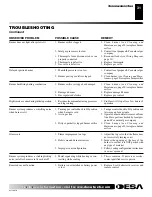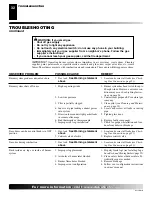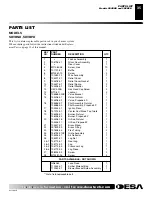
112126-01B
For more information, visit www.desatech.com
For more information, visit www.desatech.com
21
21
ON
POSITION
OFF
POSITION
WARNING: Use pipe joint sealant that is resistant
to liquid petroleum (LP) gas.
We recommend that you install a sediment trap/drip leg in supply
line as shown in Figure 40, page 20. Locate sediment trap/drip leg
where it is within reach for cleaning. Install in piping system
between fuel supply and burner system. Locate sediment trap/drip
leg where trapped matter is not likely to freeze. A sediment trap traps
moisture and contaminants. This keeps them from going into burner
system gas controls. If sediment trap/drip leg is not installed or is
installed wrong, burner system may not run properly.
To Flare Fitting on
Control Valve
Flexible Gas Line from
Equipment Shutoff Valve
Provided by Installer
Equipment
Shutoff Valve
Natural
- To
Gas Supply
Propane/LP
-
To External
Regulator
Figure 41 - Flexible Gas Line
CONNECTING STOVE/BURNER SYSTEM TO
GAS SUPPLY
Installation Items Needed
• 5/16" hex socket wrench or nut-driver
• sealant (resistant to propane/LP gas, not provided)
1.
Open lower door panel.
2.
Route flexible gas line (provided by installer, see Figure 41)
from equipment shutoff valve to burner system. Route flex-
ible gas supply line and attach to valve.
3.
Check all gas connections for leaks. See
Checking Gas
Connections,
column 2.
STOVE AND DIRECT-VENT
BURNER SYSTEM
INSTALLATION
Continued
Pressure Testing Gas Supply Piping System
Test Pressures In Excess Of 1/2 PSIG (3.5 kPa)
1.
Disconnect appliance with its appliance main gas valve (con-
trol valve) and equipment shutoff valve from gas supply pip-
ing systems. Pressures in excess of 1/2 psig (3.5 kPa) will dam-
age burner system gas regulator.
2.
Cap off open end of gas pipe where equipment shutoff valve
was connected.
3.
Pressurize supply piping system by either opening propane/LP
supply tank valve for propane/LP gas burner system or opening
main gas valve located on or near gas meter for natural gas burner
system, or using compressed air.
4.
Check all joints of gas supply piping system. Apply noncorro-
sive leak detection solution to all gas joints. Bubbles forming
show a leak. Correct all leaks at once.
5.
Reconnect burner system and equipment shutoff valve to gas
supply. Check reconnected fittings for leaks.
Test Pressures Equal To or Less Than 1/2 PSIG (3.5 kPa)
1.
Close equipment shutoff valve (see Figure 42).
2.
Pressurize supply piping system by either opening propane/LP
supply tank valve for propane/LP gas burner system or opening
main gas valve located on or near gas meter for natural gas burner
system, or using compressed air.
Figure 42 - Equipment Shutoff Valve
CHECKING GAS CONNECTIONS
WARNING: Test all gas piping and connections
for leaks after installing or servicing. Correct all
leaks at once.
WARNING: Never use an open flame to check for
a leak. Apply noncorrosive leak detection solution to
all gas joints. Bubbles forming show a leak. Correct
all leaks at once.
Open
Closed
Equipment
Shutoff
Valve
STOVE AND DIRECT-VENT BURNER SYSTEM INSTALLATION
Installing Gas Piping to Stove/Burner System Location (Cont.)
Connecting Stove/Burner System to Gas Supply
Checking Gas Connections
Apply pipe joint sealant lightly to male NPT threads. This will
prevent excess sealant from going into pipe. Excess sealant in pipe
could result in clogged burner system valves.
















































